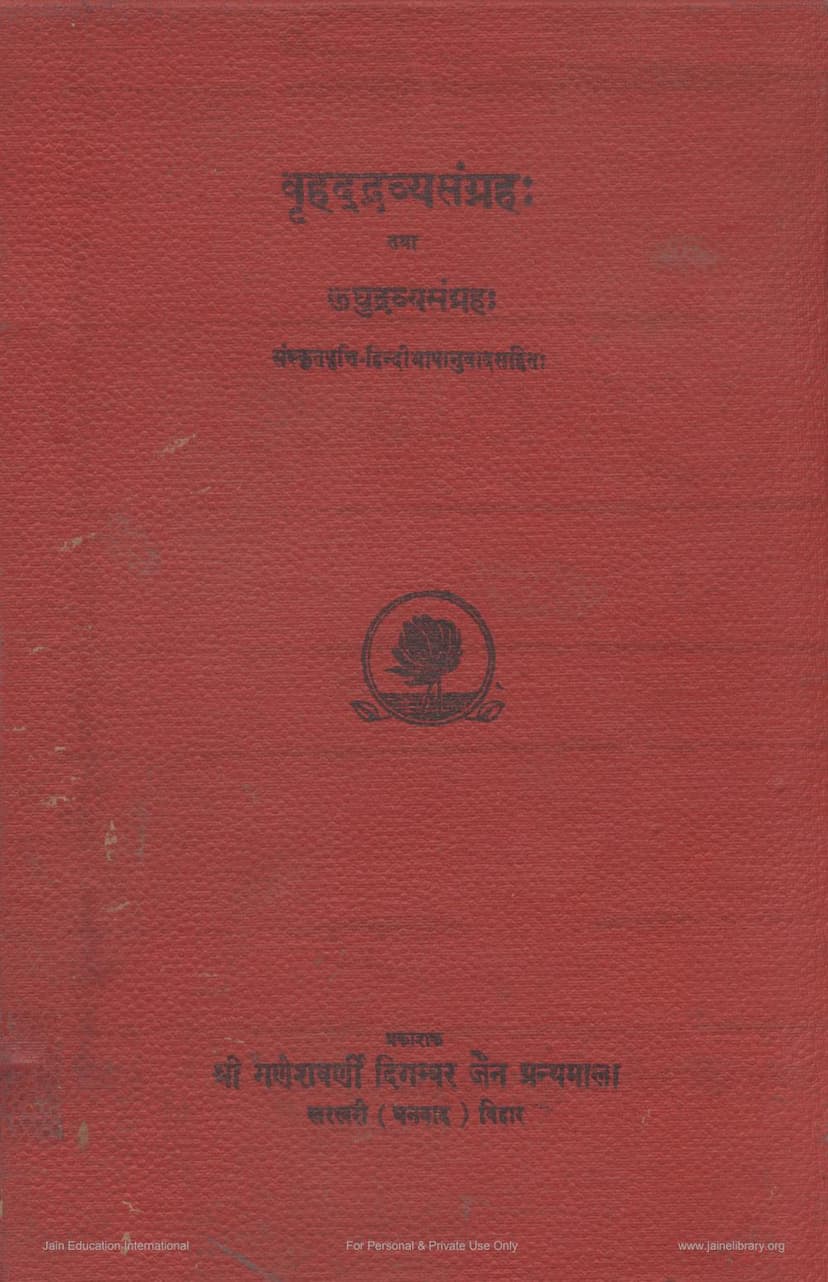Bruhad Dravya Sangraha
Added to library: September 1, 2025

Summary
Here's a comprehensive summary of the Jain text "Bruhad Dravya Sangraha" based on the provided pages:
Book Title: Bruhad Dravya Sangraha (वृहद्रव्य संग्रहः) Author(s): Nemicandra Siddhantadeva (नेमिचन्द्र सिद्धान्तदेव) is credited as the author of the main text, with Bramhadev (ब्रह्मदेव) as the author of the Sanskrit commentary and Hindi translation. Publisher: Shri Ganesh Varni Digambar Jain Granthamala (श्री गणेश वर्णी दिगम्बर जैन ग्रन्थमाला), Kharkhari (Dhanbad), Bihar. Catalog Link: https://jainqq.org/explore/004016/1
Overall Summary:
"Bruhad Dravya Sangraha," a seminal Jain philosophical text, concisely presents the core tenets of Jainism, particularly its metaphysics and the path to liberation. The work is structured into three main sections (Adhikaras) covering:
- Six Substances and Five Astikayas: This section introduces the fundamental categories of reality in Jainism, including the soul (Jiva), non-soul (Ajiva) and its constituents – matter (Pudgala), principle of motion (Dharma), principle of rest (Adharma), space (Akasha), and time (Kala). It also elaborates on the five Astikayas (entities that occupy space).
- Seven Truths and Nine Substances: This section delves into the seven tattvas (fundamental realities) that are essential for understanding the path to liberation: Jiva (soul), Ajiva (non-soul), Asrava (influx of karma), Bandha (bondage of karma), Samvara (cessation of influx), Nirjara (shedding of karma), and Moksha (liberation). It further expands on these as Nav Padarthas (nine categories of reality), often including Karma, Pudgala, and their qualities.
- The Path to Liberation: This crucial section outlines the spiritual journey towards Moksha, emphasizing the realization of the soul's true nature, the practice of Right Faith, Right Knowledge, and Right Conduct (Ratnatraya), and the importance of meditation.
The provided text includes a Sanskrit commentary by Bramhadev, which is highly regarded for its clarity, depth, and extensive citations from other Jain scriptures. The Hindi translation further enhances the accessibility of this profound work.
Key Content Highlights from the Provided Pages:
- Author and Commentary: The text is attributed to Nemicandra Siddhantadeva, a great scholar and expert in Jain philosophy and spirituality. Bramhadev authored the commentary and Hindi translation. The work was published in Samvat 2015 (1958 CE).
- Structure: The book is divided into three main sections (Adhikaras) totaling 58 verses (Gathas).
- First Adhikara: Deals with the six substances (Dravyas) and five Astikayas (Panchastikaya). It covers the nature of Jiva (soul) in detail, including its qualities, perception, and different classifications. It also describes Ajiva (non-soul) and its various components like Pudgala (matter), Dharma, Adharma, Akasha, and Kala.
- Second Adhikara: Focuses on the seven Tattvas and nine Padarthas, explaining Asrava, Bandha, Samvara, Nirjara, and Moksha. It also details the concepts of Karma, Punyas, and Papas.
- Third Adhikara: Primarily discusses the path to Moksha, emphasizing the importance of Right Faith (Samyak Darshan), Right Knowledge (Samyak Gyana), and Right Conduct (Samyak Charitra) as the means to liberation. It extensively covers various types of meditation and the characteristics of the enlightened being (Siddha).
- Nayas (Standpoints): The text frequently employs the concept of Nayas (standpoints) – Nischaya (ultimate truth) and Vyavahara (conventional truth) – to explain complex philosophical concepts, particularly the nature of the soul and its journey.
- Jiva (Soul): The nature of the soul is explained through its inherent qualities like consciousness (chetana), omniscience (Kevala Gyana), etc. Its states in bondage (samsara) and liberation (siddha) are discussed. The text highlights that the soul is inherently pure and formless (amurta).
- Ajiva (Non-soul): The text systematically describes the characteristics of matter (Pudgala), including its qualities like touch, taste, smell, and color, and its various forms from atoms to complex substances. It also explains the passive principles of motion, rest, and space, and the subtle nature of time.
- Path to Liberation (Moksha Marga): This section is central, detailing the three jewels (Ratnatraya) – Samyak Darshan, Samyak Gyana, and Samyak Charitra – as the means to break the cycle of birth and death. Meditation (Dhyana) is presented as a crucial practice.
- Detailed Indices: The published version includes comprehensive indices like a subject index, an alphabetical index of verses quoted in the commentary, a glossary of technical terms, and an alphabetical list of verses from both "Bruhad Dravya Sangraha" and "Laghu Dravya Sangraha," greatly enhancing the utility of the book for scholars and students.
- Importance: The "Bruhad Dravya Sangraha" is considered an introductory text for understanding more complex spiritual texts like "Samaysara" and is as important as "Tattvartha Sutra" for gaining foundational knowledge in Jain philosophy.
Significance:
The "Bruhad Dravya Sangraha" is a foundational text for anyone seeking to understand the core metaphysical and soteriological principles of Jainism. Its systematic approach, combined with Bramhadev's lucid commentary and translation, makes it an invaluable resource for philosophical study and spiritual practice. The emphasis on the dual perspective of Nayas (Nischaya and Vyavahara) is key to grasping the Jain worldview.